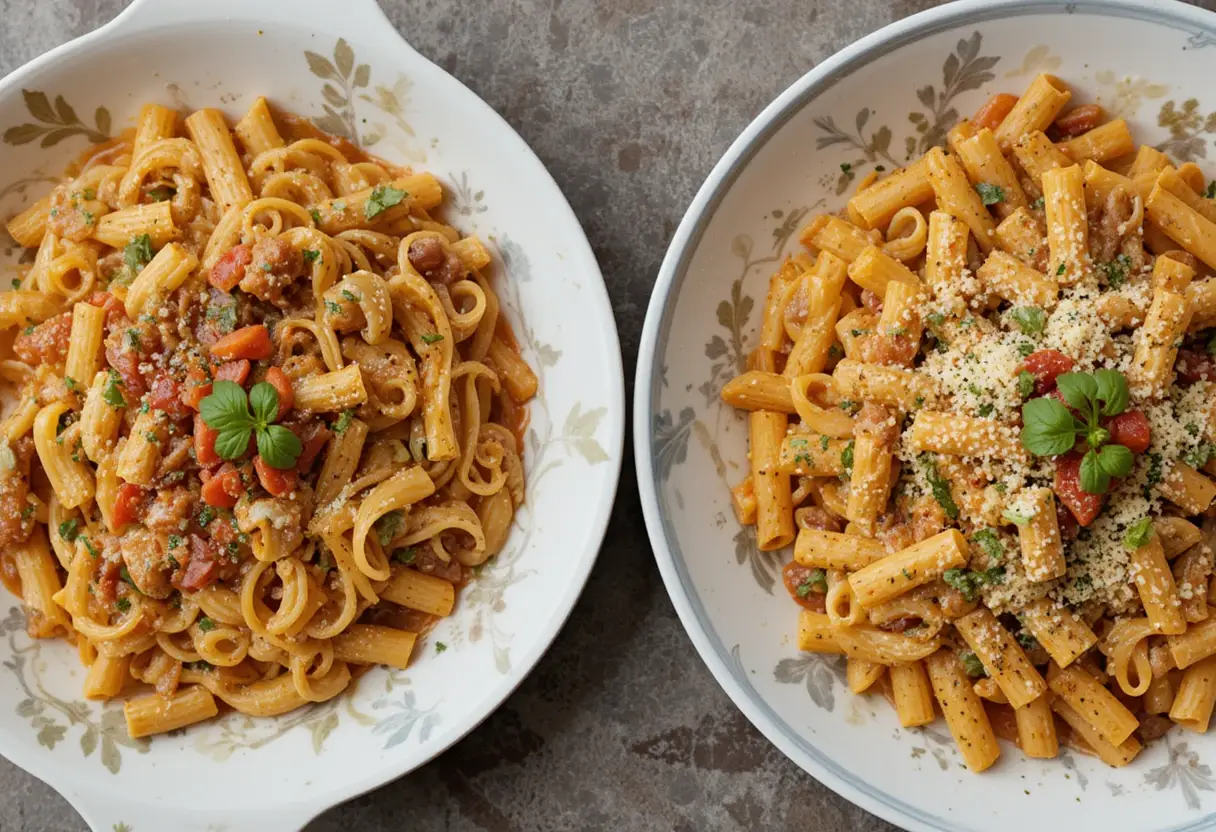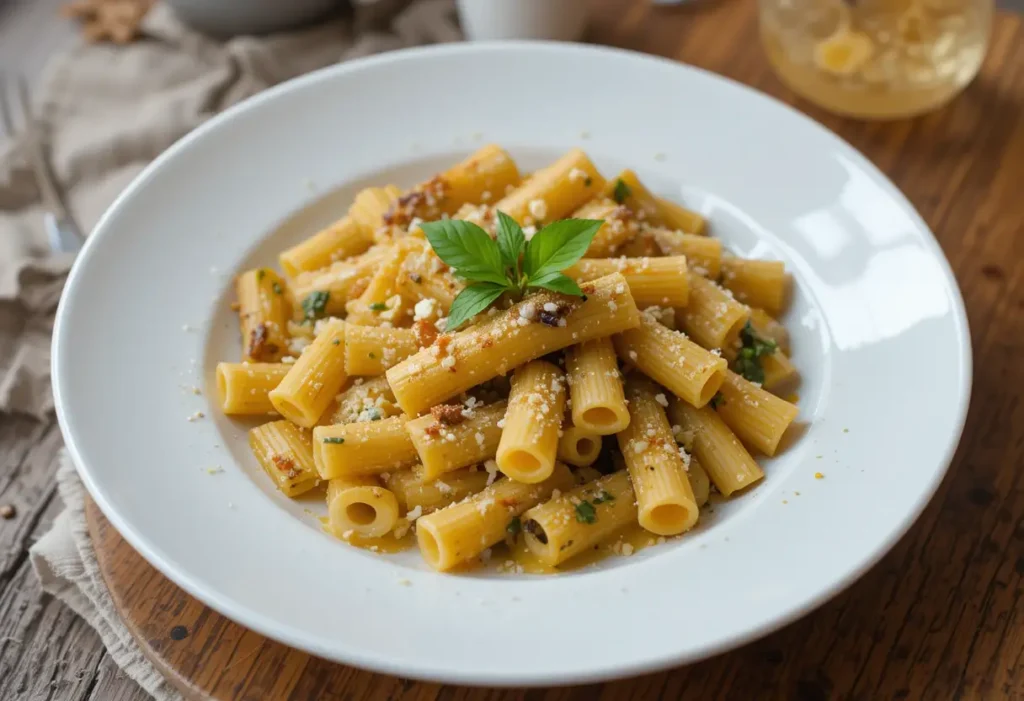Pasta comes in many shapes, each designed to complement different sauces and ingredients. Understanding the difference between ziti and rigatoni highlights how these shapes impact a dish’s taste and texture. Ziti, with its smooth surface, is perfect for baked dishes, while rigatoni, with its ridges, holds onto thicker sauces beautifully. These variations showcase why pasta remains a favorite in kitchens worldwide, offering endless versatility and flavor combinations.
The Role of Pasta Shapes in Cuisine
The shape of pasta affects how it holds sauce and blends with other ingredients. Smooth and thin pastas, like spaghetti, go best with light, simple sauces. On the other hand, ridged shapes like rigatoni pair well with thick and chunky sauces. Choosing the right pasta shape can make a good dish even better.
Table of Contents
Overview of Ziti and Rigatoni
Ziti and rigatoni are both tubular pastas often used in baked dishes and hearty meals. Ziti has a smooth surface, while rigatoni has ridges that hold sauce better. These differences make each pasta unique and perfect for different types of recipes.
What is Ziti?
Ziti is a smooth, tube-shaped pasta often used in baked dishes. It blends well with sauces and cheese, making it a popular choice for comfort foods.
Historical Origins of Ziti
The word “ziti” comes from the Italian word for “bride.” Italians traditionally served ziti at weddings and celebrations. Over time, it became a favorite in Italian-American cooking, especially in dishes like baked ziti.
Characteristics of Ziti Pasta
Ziti has a smooth surface and is cut into medium-length tubes. Its straight edges make it perfect for baking, as it soaks up sauces and combines well with other ingredients. Unlike rigatoni, ziti provides a soft and smooth texture in every bite.
Popular Dishes Featuring Ziti
Baked ziti is the most well-known dish featuring this pasta. It layers ziti with marinara sauce, ricotta, and mozzarella for a warm and satisfying meal. For a twist, you can try creamy Alfredo or spicy arrabbiata sauces. If you’re looking for similar ideas, check out the Spaghetti Casserole Recipe.
What is Rigatoni?
Rigatoni is another type of tubular pasta, but it is larger and has ridges. These ridges make it great for holding chunky sauces, which is why it’s a favorite for hearty recipes.
Historical Origins of Rigatoni
The name “rigatoni” comes from the Italian word “rigato,” which means “ridged.” It started in Southern Italy, where cooks paired it with thick, rich sauces. Today, rigatoni is enjoyed in many traditional and modern dishes.
Characteristics of Rigatoni Pasta
Rigatoni is bigger and thicker than ziti. Its ridged surface holds onto sauces and toppings, ensuring every bite is flavorful. This pasta is also sturdy, so it works well in both baked and stovetop dishes.
Popular Dishes Featuring Rigatoni
Rigatoni is popular in dishes like rigatoni alla vodka, a creamy tomato-based pasta. It’s also great in baked meals layered with meat, cheese, and sauce. For something bold, try recipes like Spicy Rigatoni, which pack a punch of flavor.
Ziti and rigatoni each bring something special to the table. Ziti works well in soft, layered dishes, while rigatoni shines in recipes with thick, hearty sauces. Whether you choose ziti or rigatoni, both can turn simple ingredients into delicious, satisfying meals.
Key Difference Between Ziti and Rigatoni
Shape and Size Comparison
Ziti and rigatoni may look similar, but their shapes and sizes set them apart. Ziti is a smooth, cylindrical pasta with straight edges, typically cut into medium-length tubes. Rigatoni, on the other hand, is slightly larger and thicker with ridges along its surface. The ridges on rigatoni make it sturdier and better at holding onto sauces.
Texture and Sauce Affinity
The main difference in texture lies in the surface of the pasta. Ziti’s smooth surface allows sauces to coat it evenly, which works well in dishes where ingredients blend together seamlessly. Rigatoni’s ridges and thicker walls give it a hearty texture, making it ideal for chunky, robust sauces that need a pasta capable of holding up under their weight.
Preferred Cooking Methods for Each Type
Ziti is most commonly used in baked dishes where the pasta can meld with sauces and cheeses. It’s often layered or mixed into casseroles. Rigatoni works well in both baked and stovetop dishes, especially those with thick, creamy, or chunky sauces. Its ridges and durability make it a favorite for recipes that require pasta to stand out.
Culinary Uses of Ziti vs Rigatoni
Ideal Sauces for Ziti
Ziti pairs best with smooth sauces that soak into the pasta. Tomato-based marinara sauces, creamy Alfredo, and even lighter oil-based sauces work beautifully. The smooth texture of ziti makes it perfect for baked dishes where it blends with ricotta, mozzarella, or béchamel.
Ideal Sauces for Rigatoni
Rigatoni is designed to hold onto thicker, chunkier sauces. Meat-based ragùs, vegetable-rich bolognese, or creamy vodka sauces cling to the ridges, ensuring every bite is flavorful. Its sturdy structure also makes it a good choice for dishes with large chunks of vegetables or meats.
Recipe Suggestions for Each Type of Pasta
- Ziti: For a classic baked pasta dish, try baked ziti, layered with marinara sauce, ricotta, and mozzarella. For a lighter option, ziti with a creamy Alfredo sauce and roasted vegetables is a delicious choice. Recipes like the Spaghetti Casserole can also serve as inspiration.
- Rigatoni: Rigatoni alla vodka is a timeless favorite, combining the ridged pasta with a creamy tomato sauce. For a heartier meal, try rigatoni with a meat-based bolognese or a chunky vegetable sauce. A bold option like Spicy Rigatoni is also worth exploring.
By understanding these key differences and culinary uses, you can confidently choose ziti or rigatoni for your next dish. Whether you’re aiming for a smooth, cheesy bake or a bold, sauce-rich pasta, these shapes bring something unique to the table.
Nutritional Comparison
Caloric Content of Ziti vs Rigatoni
When it comes to calories, ziti and rigatoni are quite similar since both are made from the same basic ingredients: wheat flour and water. On average, one cup of cooked ziti or rigatoni contains around 200–220 calories. The slight variation in caloric content depends on the brand and whether the pasta is enriched or whole-grain.
Nutritional Benefits of Each Pasta Type
Both ziti and rigatoni provide carbohydrates, which serve as a primary energy source. Enriched versions often include additional nutrients like iron and B vitamins. Whole-grain options offer more fiber, aiding digestion and keeping you full longer. While neither is inherently more nutritious, choosing whole-grain pasta can add health benefits to your meal.
Choosing Between Ziti and Rigatoni
Factors to Consider When Selecting Pasta
- Recipe Requirements: The dish you’re preparing often determines the type of pasta to use. For baked casseroles with creamy sauces, ziti is ideal. Rigatoni works better in recipes with chunky or thick sauces that need to cling to the pasta.
- Texture Preference: If you enjoy a smoother bite, choose ziti. If you like pasta with a heartier texture, rigatoni is the better option.
- Cooking Time: Ziti may cook slightly faster due to its smaller size. Keep this in mind when time is limited.
Tips for Cooking Perfect Pasta
- Use Plenty of Water: Boil pasta in a large pot of salted water to ensure even cooking and proper seasoning.
- Cook to Al Dente: Follow the cooking time on the package and taste-test toward the end. Pasta should be firm to the bite but not hard.
- Don’t Rinse: After draining, avoid rinsing pasta unless you’re using it for a cold dish. Rinsing removes the starch that helps sauces cling to the pasta.
- Reserve Pasta Water: Save a cup of the cooking water before draining. It can be used to thin or enhance your sauce.
By comparing the nutritional value and understanding the best uses for ziti and rigatoni, you can make informed choices in the kitchen. Whether you prefer ziti for a baked casserole or rigatoni for a bold, saucy dish, each pasta type brings something special to your plate. Use these tips and insights to elevate your next pasta meal!
FAQs About the difference between Ziti and Rigatoni
Which pasta is better for baking dishes?
Ziti is often considered the better choice for baked dishes due to its smooth surface and smaller size. It blends seamlessly with sauces and cheese, making it ideal for casseroles like baked ziti. However, rigatoni can also work well in baked recipes, especially if you prefer a chunkier texture and ridges that hold onto the sauce.
Can I substitute one for the other in recipes?
Yes, you can substitute ziti and rigatoni in most recipes since they share similar shapes and cooking properties. Keep in mind that rigatoni’s ridges will provide a slightly different texture and help sauces stick more, while ziti’s smooth surface may give a softer, more cohesive bite.
What are the best brands of Ziti and Rigatoni?
Several pasta brands are known for their quality:
- Barilla: Offers reliable, classic pasta options in both ziti and rigatoni.
- De Cecco: Known for its authentic Italian pasta with excellent texture and flavor.
- Rummo: A favorite for those who want slow-dried, artisanal pasta that holds up well in cooking.
- Whole-Grain Options: Brands like Banza and Jovial make whole-grain or gluten-free ziti and rigatoni for healthier choices.
How do I store and keep these pasta types?
Proper storage ensures your pasta stays fresh and ready for use:
- Dry Pasta: Keep unopened packages in a cool, dry place. After opening, store the pasta in an airtight container to prevent moisture exposure.
- Cooked Pasta: Store leftovers in an airtight container in the refrigerator for up to 3–5 days. Toss the pasta with a little olive oil to prevent sticking.
- Freezing: Cooked pasta can be frozen for longer storage. Lay it flat on a baking sheet, freeze until solid, then transfer to a freezer-safe container.
Understanding the best uses, substitutions, and storage tips for ziti and rigatoni can help you get the most out of these versatile pasta shapes. Whether you’re baking a classic dish or experimenting with new recipes, you’ll be prepared to make delicious meals every time!
Conclusion
Whether you prefer the smooth, seamless appeal of ziti or the robust, ridged versatility of rigatoni, both pasta shapes bring unique characteristics to the table. They showcase the endless possibilities of pasta and how different shapes can elevate simple ingredients into extraordinary meals. Try experimenting with recipes like Spaghetti Casserole or Spicy Rigatoni to explore the best of both worlds.
Let me know if you’d like to add more recipes or comparisons!



